By Leen Randell
Updated: Jul 04, 2024
10 Best Herbal Decoctions For Post Nasal Drip
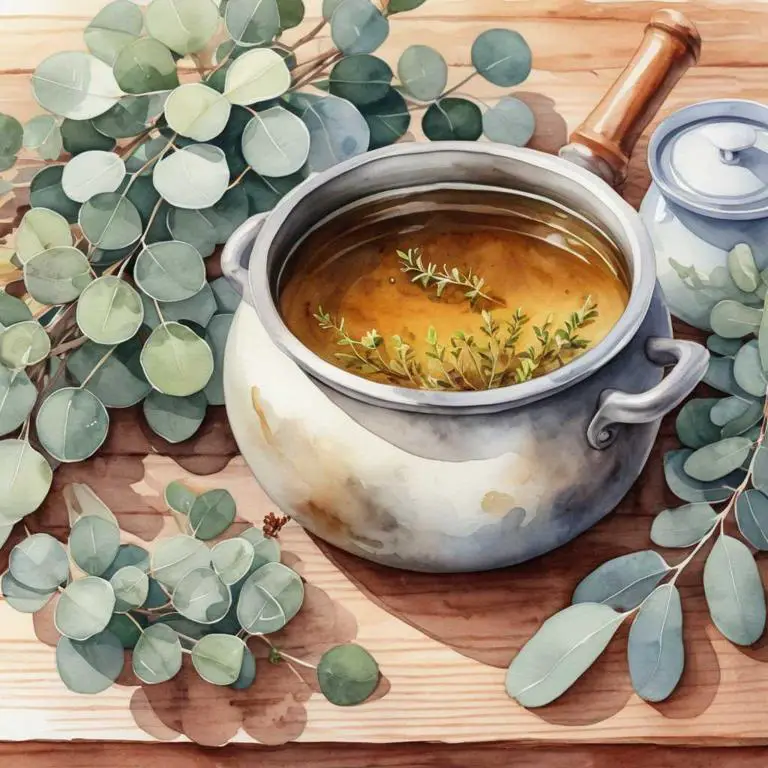
Herbal decoctions for post nasal drip are a natural remedy that combines herbs with hot water to create a soothing liquid that helps alleviate congestion and sinus pressure.
These decoctions work by loosening and thinning mucus, making it easier to expel, which in turn reduces the discomfort and frustration associated with post nasal drip. Examples of herbal decoctions that help with post nasal drip include slippery elm, marshmallow root, and peppermint tea, which can be sipped warm throughout the day to provide relief.
By using these natural remedies, individuals can improve their overall quality of life by reducing symptoms and improving their ability to breathe easily, sleep soundly, and enjoy daily activities without discomfort.
The following article describes in detail the most important decoctions for post nasal drip, including medicinal properties, parts of herbs to use, and recipes for preparations.
- 1. Glycyrrhiza glabra
- 2. Echinacea purpurea
- 3. Taraxacum officinale
- 4. Sambucus nigra
- 5. Althaea officinalis
- 6. Phellodendron amurense
- 7. Symphytum officinale
- 8. Prunus avium
- 9. Mentha x piperita
- 10. Thymus vulgaris
- What is the best combination of herbal decoctions to use for post nasal drip?
- What ailments similar to post nasal drip are treated with herbal decoctions?
1. Glycyrrhiza glabra
Licorice decoctions helps with post nasal drip because of its natural anti-inflammatory properties, which soothe and calm irritated mucous membranes in the nose and throat.
The decoction's expectorant qualities also help to loosen and clear out excess mucus, reducing congestion and discomfort.
Additionally, licorice root has been traditionally used to support lung health and promote healthy sinus function, making it a popular natural remedy for relieving post nasal drip symptoms and promoting overall respiratory well-being.

Medicinal Constituents
The list below shows the primary medicinal constituents in Glycyrrhiza glabra decoctions that help with post nasal drip.
- Saponins: Saponins help with post nasal drip by reducing inflammation and congestion in the nasal passages, making it easier to breathe and relieving the discomfort associated with excess mucus production.
- Glycyrrhizin: Glycyrrhizin has anti-inflammatory properties that help to reduce swelling and congestion in the nasal passages, while also soothing the mucous membranes and reducing the production of excess mucus.
- Flavonoids: Flavonoids, such as licoricidin and licorisoflavan A, have anti-inflammatory and antioxidant properties that help to reduce inflammation and oxidative stress in the nasal passages, which can contribute to post nasal drip.
Parts Used
The list below shows the primary parts of licorice used to make decoctions for post nasal drip.
- Roots: They are the primary source of glycyrrhizin, a compound that helps reduce inflammation and congestion in the nasal passages.
- Stems: They contain glycyrrhizin and other compounds that aid in thinning mucus, making it easier to expel.
- Barks: They contain glycyrrhizin and other saponins that help soothe and calm the nasal passages, reducing post nasal drip.
Quick Recipe
The following recipe gives a procedure to make a basic licorice for post nasal drip.
- Harvest 1-2 handfuls of dried glycyrrhiza glabra roots from a trusted source.
- Rinse the roots under cold running water to remove any impurities or debris.
- Combine the cleaned roots with 4-6 cups of water in a medium saucepan.
- Bring the water to a boil and then reduce the heat to a simmer for 10-15 minutes.
- Strain the decoction through a cheesecloth or a fine-mesh sieve into a clean container.
2. Echinacea purpurea
Purple coneflower decoctions helps with post nasal drip because of its unique combination of bioactive compounds, particularly ursolic acid and triterpenoids.
These natural components have potent anti-inflammatory and antihistamine properties that help to reduce nasal congestion and excess mucus production. The decoction's ability to soothe and calm the mucous membranes also helps to thin out thickened phlegm, making it easier to expel and alleviate postnasal drip symptoms.
Additionally, the herb's natural antimicrobial properties help to combat underlying infections that may be contributing to the condition.
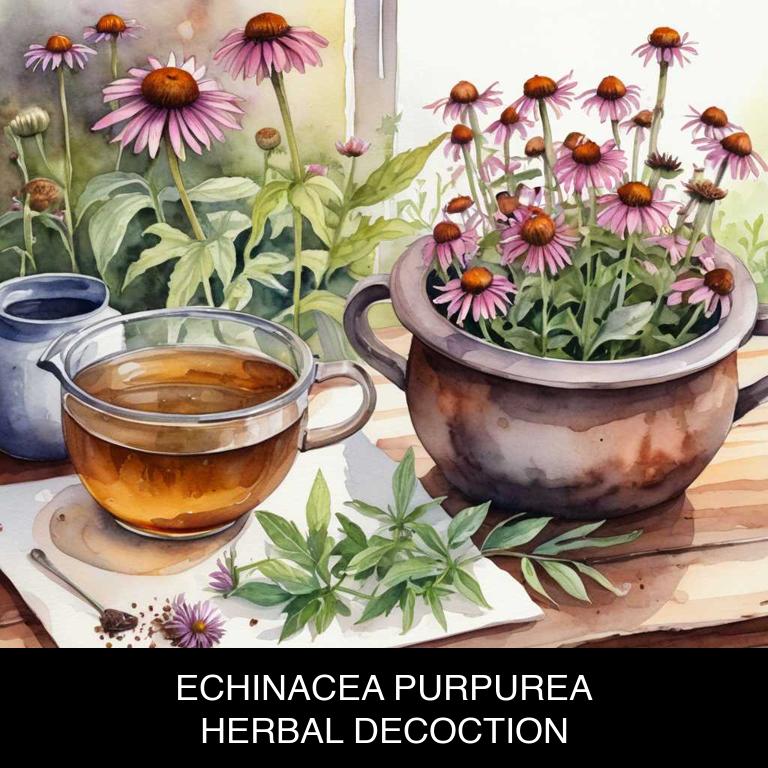
Medicinal Constituents
The list below shows the primary medicinal constituents in Echinacea purpurea decoctions that help with post nasal drip.
- Iridoid glycosides: These compounds help reduce inflammation in the nasal passages, thereby alleviating post nasal drip symptoms.
- Polyphenols: These antioxidants possess anti-inflammatory and antimicrobial properties, which help combat infections and inflammation contributing to post nasal drip.
- Cichoric acid: This compound has been shown to possess mucolytic properties, breaking down mucus and making it easier to expel, thereby relieving post nasal drip symptoms.
Parts Used
The list below shows the primary parts of purple coneflower used to make decoctions for post nasal drip.
- Roots: They contain compounds like polysaccharides and glycoproteins that help stimulate the immune system and reduce inflammation.
- Leaves: They are rich in antioxidants and flavonoids that have anti-inflammatory properties, which can help alleviate post nasal drip symptoms.
- Flowers: They contain alkylamides and caffeic acid derivatives that have antiviral and anti-inflammatory properties, helping to combat infections and reduce nasal congestion.
Quick Recipe
The following recipe gives a procedure to make a basic purple coneflower for post nasal drip.
- Gather 2-4 ounces of fresh echinacea purpurea flowers and roots or 1-2 teaspoons of dried echinacea purpurea flowers and roots.
- Combine the echinacea purpurea flowers and roots with 32 ounces of water in a saucepan and bring to a boil.
- Reduce the heat to a simmer for 5-10 minutes or 15-30 minutes for a stronger decoction.
- Strain the decoction through a cheesecloth or a fine-mesh sieve into a bowl and discard the solids.
- Store the decoction in the refrigerator for up to 3 days or freeze for later use.
3. Taraxacum officinale
Dandelion decoctions helps with post nasal drip because of its anti-inflammatory properties, which help to reduce swelling in the nasal passages and sinuses.
The decoction also contains antioxidants that combat free radicals, which can exacerbate postnasal drip symptoms such as congestion and mucous production. Additionally, dandelion's natural astringent properties help to dry up excess mucus, providing relief from clogged noses and sinus pressure.
By soothing and cleansing the nasal passages, dandelion decoctions can effectively alleviate postnasal drip symptoms.

Medicinal Constituents
The list below shows the primary medicinal constituents in Taraxacum officinale decoctions that help with post nasal drip.
- Flavonoids: These plant compounds help reduce inflammation in the nasal passages and sinuses, thereby alleviating symptoms of post nasal drip.
- Apigenin: This flavonoid acts as an antihistamine, reducing the production of histamine, a chemical that can trigger symptoms of post nasal drip such as sneezing and congestion.
- Taraxasterol: This triterpenoid saponin has anti-inflammatory properties, which help to reduce swelling and irritation in the nasal passages and sinuses, making it easier to breathe and alleviating symptoms of post nasal drip.
Parts Used
The list below shows the primary parts of dandelion used to make decoctions for post nasal drip.
- Leaves: Their diuretic and expectorant properties help to thin mucus and promote its removal from the nasal passages.
- Roots: Rich in inulin and other compounds that have anti-inflammatory and antimicrobial effects, helping to reduce congestion and fight off underlying infections.
- Flowers: With their bitter compounds and anti-inflammatory properties, they help to stimulate digestion, reduce mucus production, and relieve nasal congestion.
Quick Recipe
The following recipe gives a procedure to make a basic dandelion for post nasal drip.
- Harvest the fresh or dried taraxacum officinale roots in the morning after the dew has evaporated.
- Dry the harvested roots in a low-temperature oven at 105 degrees fahrenheit for two hours.
- Grind 2-3 teaspoons of the dried roots into a fine powder using a mortar and pestle.
- Steep 1 teaspoon of the powdered root in 8 ounces of boiling water for 10 minutes.
- Strain the decoction and discard the solids to obtain the herbal remedy.
4. Sambucus nigra
Elder decoctions helps with post nasal drip because they contain anti-inflammatory compounds that soothe and reduce congestion in the nasal passages.
The decongestant properties of elder help to thin out mucus, making it easier to expel, and reduce swelling in the nasal tissues, allowing for improved airflow. Additionally, elder's antimicrobial properties help to combat underlying infections that may be contributing to post nasal drip.
Overall, elder decoctions provide natural relief from the discomfort and congestion associated with post nasal drip.
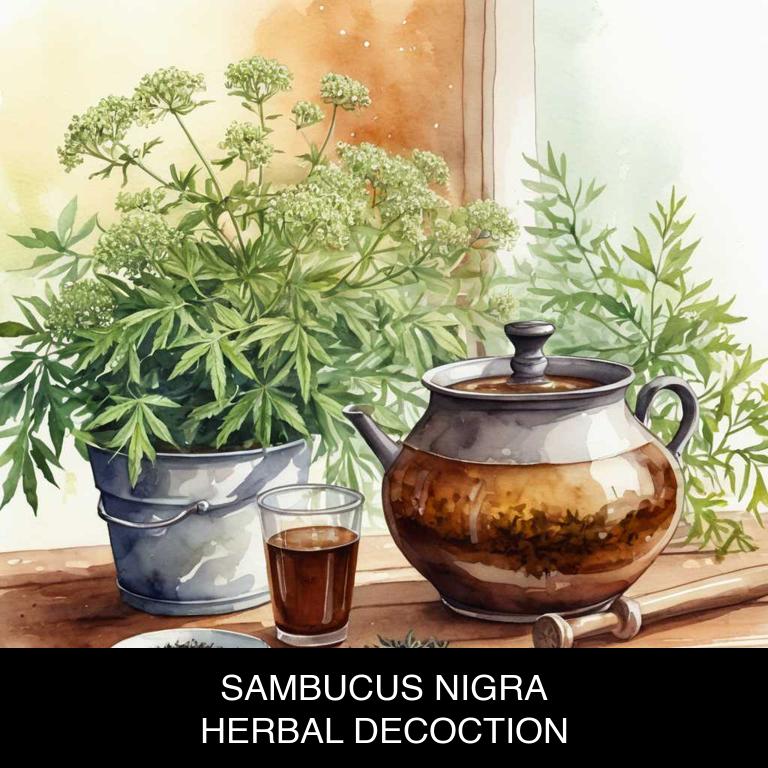
Medicinal Constituents
The list below shows the primary medicinal constituents in Sambucus nigra decoctions that help with post nasal drip.
- Flavonoids: Flavonoids in Sambucus nigra, particularly quercetin and kaempferol, have anti-inflammatory properties that help reduce nasal congestion and post nasal drip by inhibiting the production of pro-inflammatory enzymes.
- Phenolic acids: Phenolic acids, such as salicylic acid and ferulic acid, in Sambucus nigra decoctions exhibit antiseptic and anti-inflammatory properties that help combat infections and reduce inflammation in the nasal passages, thereby alleviating post nasal drip.
- Tannins: Tannins in Sambucus nigra, including ellagic acid, have astringent properties that help reduce mucus production and alleviate post nasal drip by binding to mucins and promoting their clearance from the nasal passages.
Parts Used
The list below shows the primary parts of elder used to make decoctions for post nasal drip.
- Flowers: They are used due to their antiviral and expectorant properties, which help in relieving congestion and reducing post nasal drip.
- Leaves: They are used due to their antibacterial and anti-inflammatory properties, which help in soothing the throat and reducing inflammation associated with post nasal drip.
- Fruits: They are used due to their high water content and soothing properties, which help in thinning mucus and providing relief from post nasal drip.
Quick Recipe
The following recipe gives a procedure to make a basic elder for post nasal drip.
- Harvest 20-30 grams of fresh or 10-15 grams of dried sambucus nigra flowers and leaves in the summer months.
- Cut the sambucus nigra material into small pieces and add them to a large pot with 2 liters of water.
- Bring the water to a boil then reduce the heat to a low simmer for 10-15 minutes.
- Strain the decoction through a cheesecloth or a fine-mesh sieve into a clean container discarding the solids.
- Allow the decoction to cool and store it in the refrigerator for up to 3 days or freeze it for later use.
5. Althaea officinalis
Marshmallow decoctions helps with post nasal drip because they provide a soothing and protective barrier to the mucous membranes in the throat and nasal passages.
The saponins present in marshmallows have anti-inflammatory properties that help reduce swelling and calm irritated tissues, allowing for easier mucus clearance and relief from congestion.
Additionally, marshmallow decoctions can help thin out excess mucus, making it less sticky and easier to expel, providing lasting relief from the discomfort of post nasal drip.

Medicinal Constituents
The list below shows the primary medicinal constituents in Althaea officinalis decoctions that help with post nasal drip.
- Mucilages: Mucilages in Althaea officinalis decoctions help with post nasal drip by forming a protective barrier on the mucous membranes, soothing and calming irritated tissues, and promoting the clearance of excess mucus and debris.
- Althaea flavonoids: Althaea flavonoids have anti-inflammatory properties that help reduce swelling and inflammation in the nasal passages, which can contribute to post nasal drip. By reducing inflammation, they promote a healthier environment for mucus to drain and clear.
- Rhamnose: Rhamnose, a type of sugar found in Althaea officinalis decoctions, has been shown to have a mucolytic effect, helping to break down and thin mucus, making it easier to expel and reducing the sensation of post nasal drip.
Parts Used
The list below shows the primary parts of marshmallow used to make decoctions for post nasal drip.
- Roots: The roots are the most commonly used part of Althaea officinalis due to their high mucilage content, which helps soothe and protect the mucous membranes.
- Leaves: The leaves are also used for their mucilage properties and are often combined with roots to create a more potent decoction.
- Flowers: The flowers are sometimes used in Althaea officinalis decoctions for their additional mucilage content and potential anti-inflammatory properties.
Quick Recipe
The following recipe gives a procedure to make a basic marshmallow for post nasal drip.
- Gather 10 to 20 grams of dried root of althaea officinalis for decoction.
- Clean and chop the dried root into smaller pieces to increase surface area.
- Place the chopped root in a saucepan and add 1 liter of water for decoction.
- Boil the water for 10 to 15 minutes to extract the active compounds from the root.
- Strain the decoction through a cheesecloth or a fine-mesh sieve into a clean container.
6. Phellodendron amurense
Amur corktree decoctions helps with post nasal drip because of its natural antitussive and anti-inflammatory properties.
The decoction's active compounds, such as phlobaphene and quercetin, effectively soothe and calm the mucous membranes in the nose and throat, reducing excess mucus production and congestion. This relief enables the body to clear out excess mucus more efficiently, providing quick and effective alleviation of post nasal drip symptoms.
The decoction also helps to thin out thick mucus, making it easier to expel, further enhancing its beneficial effects.
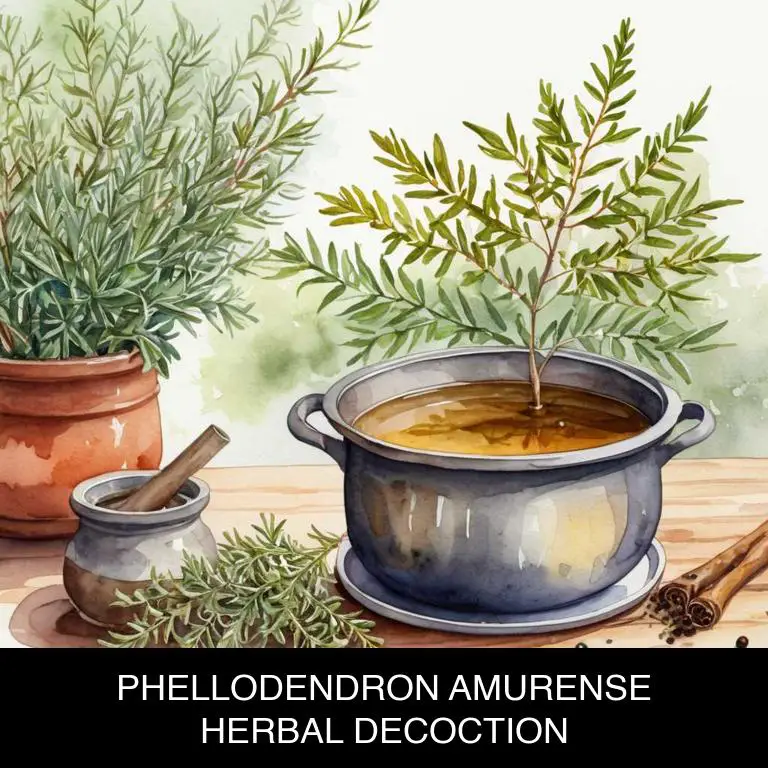
Medicinal Constituents
The list below shows the primary medicinal constituents in Phellodendron amurense decoctions that help with post nasal drip.
- Berberine: A bioactive alkaloid that has antimicrobial properties, helping to reduce the growth of bacteria and fungi in the nasal passages, which may contribute to post nasal drip.
- Phellodendrine: A phenolic alkaloid that has anti-inflammatory properties, which may help reduce inflammation in the nasal passages and alleviate post nasal drip symptoms.
- Oleanolic acid: A triterpenoid saponin that has anti-inflammatory and antiviral properties, which may help reduce nasal inflammation and combat viral infections that may contribute to post nasal drip.
Parts Used
The list below shows the primary parts of amur corktree used to make decoctions for post nasal drip.
- Barks: Used due to its purported decongestant and anti-inflammatory properties.
- Roots: Used due to its claimed ability to clear mucus and relieve nasal congestion.
- Leaves: Used due to its supposed decongestant and expectorant properties to help with mucus clearance.
Quick Recipe
The following recipe gives a procedure to make a basic amur corktree for post nasal drip.
- Gather 30-60g of dried phellodendron amurense bark and store it in a cool dry place.
- Boil 2-3 cups of water in a saucepan and then reduce heat to a simmer.
- Add the dried bark to the simmering water and let it steep for 10-15 minutes.
- Strain the decoction through a cheesecloth or fine-mesh sieve into a clean container.
- Discard the solids and let the decoction cool to room temperature for later use.
7. Symphytum officinale
Comfrey decoctions helps with post nasal drip because it contains a wealth of bioactive compounds that help to soothe and calm irritated mucous membranes in the throat, nose, and sinuses.
The anti-inflammatory properties of comfrey's allantoin and rosmarinic acid work together to reduce swelling and congestion, while its expectorant qualities help to loosen and clear out mucus, providing fast relief from the discomfort and congestion associated with post nasal drip.
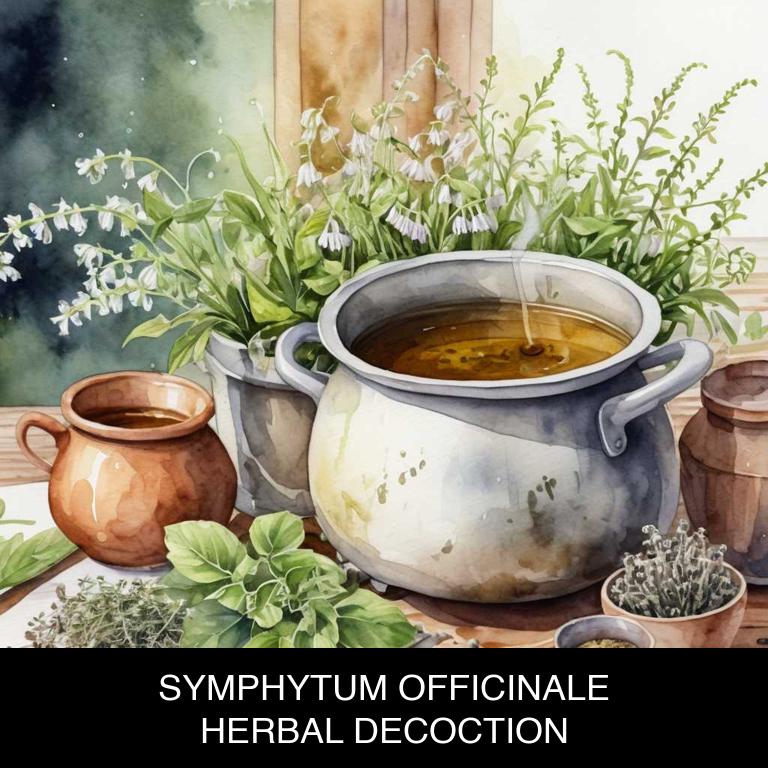
Medicinal Constituents
The list below shows the primary medicinal constituents in Symphytum officinale decoctions that help with post nasal drip.
- Iridoid glycosides: These compounds help reduce inflammation and mucus production in the nasal passages, thereby alleviating post nasal drip symptoms.
- Saponins: Saponins in Symphytum officinale decoctions exhibit anti-inflammatory and expectorant properties, helping to break down and clear mucus from the nasal passages.
- Flavonoids: Flavonoids present in these decoctions possess antioxidant and anti-inflammatory properties, which help to soothe and protect the mucous membranes in the nasal passages, reducing post nasal drip.
Parts Used
The list below shows the primary parts of comfrey used to make decoctions for post nasal drip.
- Leaves: The leaves are used due to their rich content of mucilage, which helps to soothe and protect the mucous membranes in the nasal passages.
- Roots: The roots are used for their expectorant properties, which aid in loosening and removing mucus from the respiratory tract.
- Stems: The stems are used for their similar properties to the leaves, containing mucilage that helps to calm and protect the nasal passages.
Quick Recipe
The following recipe gives a procedure to make a basic comfrey for post nasal drip.
- Harvest 20-30 grams of dried root and leaf material of symphytum officinale from a trusted source.
- Weigh and mix the harvested symphytum officinale material with 500 milliliters of water in a clean saucepan.
- Boil the water and symphytum officinale mixture for 10-15 minutes over medium heat.
- Reduce heat and simmer the decoction for an additional 10-15 minutes to enhance bioavailability.
- Strain the decoction through a cheesecloth or fine-mesh sieve into a clean container for storage.
8. Prunus avium
Cherry decoctions helps with post nasal drip because they contain anthocyanins, powerful antioxidants that reduce inflammation in the nasal passages and sinuses.
The decoction's natural anti-inflammatory properties help to thin and clear mucus, alleviating congestion and sinus pressure. Additionally, cherry decoctions' antimicrobial properties combat viral and bacterial infections that can cause excess mucus production.
By soothing and clearing the nasal passages, herbal cherry decoctions provide effective relief from post nasal drip and related discomforts.
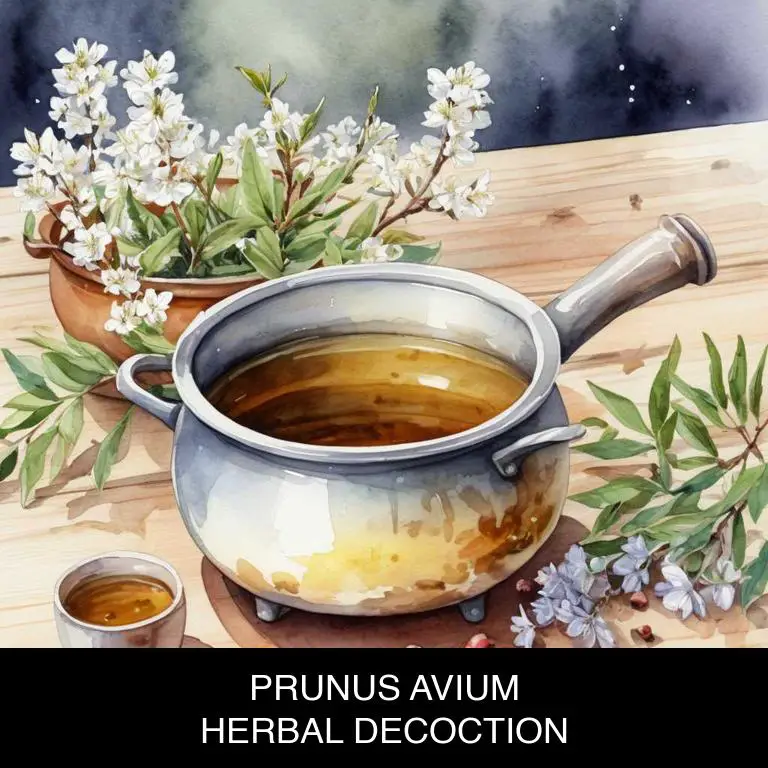
Medicinal Constituents
The list below shows the primary medicinal constituents in Prunus avium decoctions that help with post nasal drip.
- Flavonoids: Flavonoids in Prunus avium decoctions help alleviate post nasal drip by reducing inflammation and congestion in the nasal passages, which helps to clear excess mucus.
- Phenolic acids: Phenolic acids, such as chlorogenic and caffeic acids, present in Prunus avium decoctions possess antimicrobial properties that help combat underlying infections causing post nasal drip.
- Terpenoids: Terpenoids, including limonene and pinene, in Prunus avium decoctions exhibit expectorant properties, helping to loosen and clear mucus from the nasal passages and lungs.
Parts Used
The list below shows the primary parts of cherry used to make decoctions for post nasal drip.
- Leaves: Used to treat coughs and respiratory issues due to their expectorant properties.
- Fruits: Used to treat digestive issues and may also have anti-inflammatory properties.
- Buds: Used to treat respiratory issues such as bronchitis and may also have anti-inflammatory properties.
Quick Recipe
The following recipe gives a procedure to make a basic cherry for post nasal drip.
- Gather 10-15 prunus avium leaves and stems, clean them thoroughly with cold water, and chop them into small pieces.
- Combine the chopped prunus avium with 1 quart of cold water in a saucepan, bring to a boil,.
- Strain the mixture through a cheesecloth or fine-mesh sieve into a large bowl, discard the solids.
- Collect the liquid and add 1 tablespoon of honey to enhance flavor and sweetness, stir well to combine.
- Allow the decoction to cool completely, then refrigerate it for up to 3 days, before using as needed.
9. Mentha x piperita
Peppermint decoctions helps with post nasal drip because of its natural ability to soothe and relax the mucous membranes in the throat and nasal passages.
The menthol content in peppermint has a decongestant effect, reducing excess mucus production and thickening the existing mucus, making it easier to expel.
Additionally, the decoction's cooling properties help calm irritated tissues, reducing inflammation and discomfort associated with post nasal drip, providing quick relief from congestion and sinus pressure.

Medicinal Constituents
The list below shows the primary medicinal constituents in Mentha x piperita decoctions that help with post nasal drip.
- Menthol: Menthol is a key terpene in peppermint oil, which has a decongestant effect by thinning mucus, making it easier to expel from the nasal passages and reducing post nasal drip.
- Rosmarinic acid: A phenolic compound, rosmarinic acid has potent anti-inflammatory and antioxidant properties, helping to alleviate nasal congestion and post nasal drip by reducing inflammation in the nasal passages and promoting overall respiratory health.
- Limonene: A terpene found in peppermint oil, limonene has been shown to exhibit antimicrobial properties, which can help prevent the growth of bacteria and other microorganisms that contribute to post nasal drip.
Parts Used
The list below shows the primary parts of peppermint used to make decoctions for post nasal drip.
- Leaves: Their essential oils help to clear mucus and reduce congestion.
- Stems: The stems are used to make teas that ease respiratory issues and soothe the throat.
- Roots: The roots of Mentha x piperita are used to create decoctions that help to thin mucus and promote its expulsion.
Quick Recipe
The following recipe gives a procedure to make a basic peppermint for post nasal drip.
- Harvest 1/2 cup of fresh mentha x piperita leaves and flowers in the morning for optimal oil content.
- Chop the harvested plant material into small pieces and store it in a clean glass container for later use.
- Combine 1/2 cup of chopped plant material with 2 cups of boiling water in a heat-resistant glass or ceramic container.
- Steep the mixture for 5-7 minutes or until the liquid has cooled to room temperature and the flavors have infused.
- Strain the liquid through a cheesecloth or a fine-mesh sieve into a clean glass container discarding the solids.
10. Thymus vulgaris
Thyme decoctions helps with post nasal drip because of its natural expectorant properties, which help to loosen and clear out mucus from the nasal passages.
The antimicrobial compounds in thyme, such as thymol and carvacrol, also aid in reducing inflammation and combatting any underlying infections that may be contributing to the postnasal drip.
By soothing the mucous membranes and reducing excess mucus production, thyme decoctions can provide relief from this frustrating and uncomfortable condition.
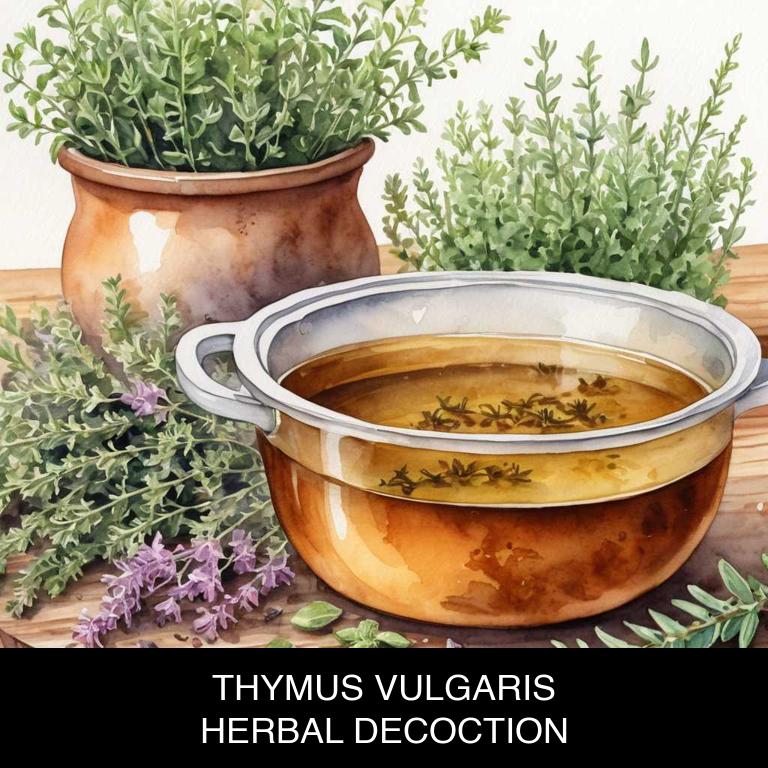
Medicinal Constituents
The list below shows the primary medicinal constituents in Thymus vulgaris decoctions that help with post nasal drip.
- Caryophyllene oxide: This sesquiterpene acts as a natural antitussive and anti-inflammatory agent, helping to alleviate post nasal drip symptoms by reducing congestion and coughing.
- Thymol: A phenolic compound, thymol exhibits antimicrobial and anti-inflammatory properties, which help combat the underlying infections and inflammation causing post nasal drip.
- Rosmarinic acid: This polyphenolic compound possesses potent anti-inflammatory and antioxidant properties, helping to reduce inflammation and oxidative stress in the nasal passages, thereby alleviating post nasal drip symptoms.
Parts Used
The list below shows the primary parts of thyme used to make decoctions for post nasal drip.
- Leaves: Leaves are commonly used due to their high concentration of thymol, a compound with antimicrobial and decongestant properties that can help alleviate post-nasal drip.
- Stems: Stems contain thymol and other essential oils that contribute to their use in treating post-nasal drip by reducing inflammation and promoting drainage.
- Buds: Buds are also used due to their high thymol content, which helps to combat infection and reduce mucus production associated with post-nasal drip.
Quick Recipe
The following recipe gives a procedure to make a basic thyme for post nasal drip.
- Gather 20 grams of fresh thymus vulgaris leaves and flowers or 10 grams of dried material for decoction.
- Rinse the thymus vulgaris material with cold water to remove dirt and debris from the surface.
- Combine the thymus vulgaris material with 1 liter of boiling water in a heat-resistant container.
- Steep the mixture for 10 to 15 minutes in a covered container to allow the herbs to infuse.
- Strain the liquid through a cheesecloth or a fine-mesh sieve to separate the solids from the decoction.
What is the best combination of herbal decoctions to use for post nasal drip?
The best combination of herbal decoctions that help with post nasal drip is a blend of Echinacea, Ginger, and Thyme.
Echinacea helps to boost the immune system and fight off underlying infections. Ginger has natural anti-inflammatory properties that soothe the nasal passages and reduce congestion. Thyme, with its antimicrobial properties, helps to eliminate bacteria and fungi that can contribute to post nasal drip.
Drinking these decoctions regularly can help alleviate symptoms and promote overall respiratory health.
What ailments similar to post nasal drip are treated with herbal decoctions?
Ailments similar to post nasal drip that are treated with herbal decoctions are chronic sinusitis, bronchial congestion, and allergies.
Herbal decoctions such as yarrow tea, which has anti-inflammatory properties, can help alleviate sinus pressure and congestion. Ginger tea is also effective in soothing a sore throat and reducing inflammation associated with these conditions. Additionally, herbs like peppermint and eucalyptus can be used to ease congestion and open up airways.
These herbal remedies can provide natural relief from symptoms similar to post nasal drip.